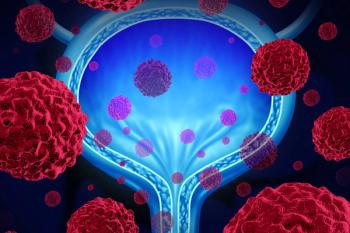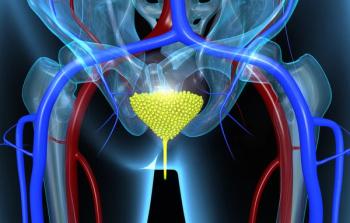
Study Shows Promise for UGN-101 in Low-Grade Upper Tract Urothelial Cancer
The study, titled OLYMPUS, suggested that primary chemoablation of low-grade upper tract urothelial cancer with intracavitary UGN-101 resulted in clinically significant disease eradication.
An open-label, single-arm, phase III study published in The Lancet Oncology assessed the safety and activity of non-surgical treatment in low-grade upper tract urothelial cancer using instillation of UGN-101 (Jelmyto), a mitomycin-containing reverse thermal gel.1
The OLYMPUS study suggested that primary chemoablation of low-grade upper tract urothelial cancer with intracavitary UGN-101 resulted in clinically significant disease eradication, and may offer a kidney-sparing treatment alternative for this patient population.
Proof-of-concept and preliminary safety data for UGN-101 were previously reported using data from a compassionate-use program which treated 22 patients with upper tract urothelial cancer.
“UGN-101 is semi-solid at body temperature and becomes a viscous liquid at colder temperatures that can be injected via a catheter passed from the bladder into the renal pelvis where these tumors occur,” corresponding and senior author Seth P. Lerner, MD, FACS, professor of urology and Beth and Dave Swalm Chair in Urologic Oncology at Baylor, said in a press release.2 “The reverse thermal properties of UGN-101 allow for local administration of mitomycin as a liquid, which subsequently transforms into a semi-solid gel depot as it warms up following instillation into the urinary upper tract. Normal urine flow dissolves the gel depot, allowing tissue exposure to mitomycin over a period of 4 to 6 hours.”
Participants in the trial were recruited from 24 academic sites in the US and Israel. Patients enrolled included those aged ≥18 years with primary or recurrent biopsy-proven, low-grade upper tract urothelial cancer, measuring 5-15 mm in maximum diameter), and an Eastern Cooperative Oncology Group performance status score of less than 3.
Participants received 6 instillations of once-weekly UGN-101 (mitomycin 4 mg per mL; dosed according to volume of patient’s renal pelvis and calyces, maximum 60 mg per instillation) via retrograde catheter to the renal pelvis and calyces. Complete response was assessed 4-6 weeks after the completion of initial therapy, defined as negative 3-month ureteroscopic evaluation, negative cytology, and negative for-cause biopsy. Moreover, activity and safety were evaluated by investigator in all those who received at least 1 dose of UGN-101.
Ultimately, between April 6, 2017 and November 26, 2018, 71 (96%) of 74 enrolled patients were given at least 1 dose of UGN-101. Overall, 42 (59%; 95% CI, 47-71; P < 0.0001) patients had a complete response at the time of primary disease evaluation. The median follow-up for patients with a complete response was 11.0 months (IQR 5.1-12.4).
The most frequently observed all-cause adverse events (AEs) were ureteric stenosis (44%), urinary tract infection (32%), hematuria (31%), flank pain (30%), and nausea (17%). Additionally, 27% had study drug-related or procedure-related serious AEs, though no deaths were found to be treatment related.
“The clear benefit is that patients get to keep their kidney. For people who have one kidney, this option also removes the need for dialysis,” Lerner said. “Other potential beneficiaries would be patients for whom, because of other conditions, it would be too risky to perform an operation to remove the kidney. Now they have an option for treatment.”
Recently, the FDA approved the treatment of UGN-101, making the treatment the first and only approved non-surgical treatment available for patients with low-grade upper tract urothelial cancer. However, researchers will continue to monitor the durability of initial response out to 12 months.
“This novel kidney-sparing approach might offer an important alternative for patients with low-grade upper tract urothelial cancer and expand the treatment options for patients with tumors that are difficult to treat endoscopically,” the study authors wrote.
References:
1. Kleinmann N, Matin SF, Pierorazio PM, et al. Primary chemoablation of low-grade upper tract urothelial carcinoma using UGN-101, a mitomycin-containing reverse thermal gel (OLYMPUS): an open-label, single-arm, phase III trial. The Lancet Oncology. doi:10.1016/S1470-2045(20)30147-9.
2. New option for treating upper tract urothelial cancer [news release]. Houston, TX. Published April 30, 2020.
Newsletter
Stay up to date on recent advances in the multidisciplinary approach to cancer.
















































































